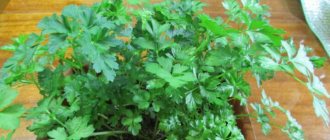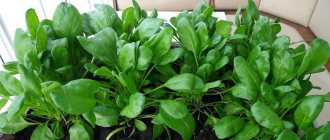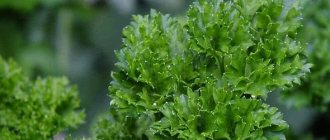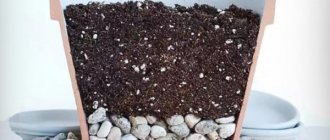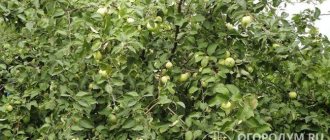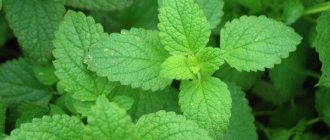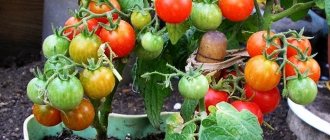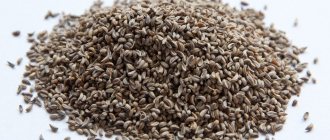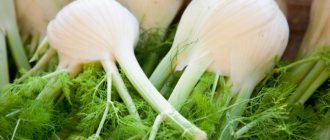Is it possible to grow parsley on a windowsill?
Such greens are classified as frost-resistant plants - if the conditions are provided, you can get a harvest even on the balcony. The minimum thermometer readings for growing such greens do not exceed 10ºC. But, before sowing seeds or planting root crops in the ground, you need to carry out preparatory measures - choose a variety with high yield, a place for the container, mix the substrate and buy a lamp for additional illumination.
Uses of plant root
You can use the root to grow greens in a pot. The material is dug up in the garden in the fall and bought at the store. The upper part - the shoot with leaves - must be cut with scissors. A small tail of up to 2 cm remains. If the root is long, remove the lower part; this will not harm the plant. When planting, the upper part of the root and the remains of the stem remain on the surface. The technology is similar to planting root crops. Thanks to the use of a strong, healthy root, the greens will be juicy and aromatic.
After a few months, flower stalks form. Parsley produces inflorescences with yellow-green small flowers. This is normal for the second year of plant development. Once the fruits have ripened, the seeds can be collected.
Features of growing parsley at home
Growing parsley at home has undoubted advantages:
- the opportunity to cut tasty and fresh greens in winter, summer, spring and autumn;
- obtaining environmentally friendly greens, the quality and benefits of which you are 100% sure of;
- saving money, because you don’t need to buy parsley in stores.
However, it is important to be aware of the difficulties that may arise. Firstly, it is necessary to provide the plants with optimal conditions and care (we will talk about this below). For example, in winter, certain manipulations with lighting will be required (additional lighting with phytolamps), because there will not be enough natural light.
However, don’t be afraid of the difficulties, because parsley won’t require any extra effort from you, and all the costs will more than pay off!
What are the beneficial properties of parsley?
The spicy plant is very beneficial for our body, I will introduce you to the main beneficial properties of greens and parsley root.
- The complex of vitamins and microelements strengthens the immune system and saturates the body with necessary enzymes.
- Parsley has a beneficial effect on the children's body.
- Potassium and magnesium improve the functioning of the circulatory system and vision.
- Ascorbic acid and iodine increase hemoglobin and normalize the function of the endocrine system.
- Fiber cleanses the kidneys and liver of waste and toxins, strengthens bones and muscles.
- Phytohormones increase potency in men.
- B vitamins stabilize the nervous system and normalize metabolism.
- Folic acid promotes favorable gestation.
- The juice is used in cosmetology as a bleaching agent.
Author's note
Natalia Papanova
Blog author
Friends, all products are healthy in moderation. Abuse can cause hallucinations, allergies and gastrointestinal upset.
Watch a video about the benefits of parsley.
What types and varieties of parsley can be grown in an apartment?
Parsley comes in two types:
- Root - grown to produce root crops.
- Leafy - used to produce greens. Leaf parsley can be: Ordinary.
- Curly.
Leaf parsley (both regular and curly) is more suitable for growing at home.
But it is not advisable to plant a root variety in an apartment, because to grow root crops, the plant requires large containers that will take up a lot of space on the windowsill.
There are two ways to propagate parsley:
- Seeds. This method is very simple and convenient, and is not much different from sowing seeds of other crops. However, with this method, the first greens can be obtained at a later date (approximately 1.5-2 months after planting). When sown through seeds, parsley can be grown for a long time (throughout the whole year), and the harvest will be greater.
- Root crops or roots. A less popular method of propagation, the advantage of planting roots/rhizomes is that the first greenery will grow in about 3-4 weeks. However, there is also an obvious disadvantage: the roots of the plant will quickly become depleted, and it will not be able to grow for a long time; the root crop or roots will have to be replanted.
As for specific varieties, the following varieties are most suitable for growing at home:
- Ordinary parsley: Grandmother's bed, Gloria, Ordinary, Morning freshness, Beads, Appetizing, Fitness, Russian feast.
- Curly parsley: Mooskrause 2, Astra, Emerald lace, Green pearl, Vorozheya.
Advice! It is best to choose early varieties of parsley.
Varieties of curly parsley
Curly parsley grows very well on a windowsill, especially since there are special varieties for growing in such conditions:
- Astra . High germination, good yield. After pruning or plucking, the leaves grow back quickly.
- Mooskrause 2 . This variety has a high content of essential oils, so the aroma is persistent and well expressed. The leaves are large and carved.
- Lace . The leaves of this variety are highly corrugated and emit a persistent odor. Grows back well after cutting.
- Kucheryavets . First harvest after 3 weeks of growth. The first leaves are very soft and tender. An adult plant reaches a height of 20 centimeters. Suitable for growing on the balcony.
- Harvest . A variety with increased productivity. Up to 5 cuts per season. Keeps fresh for a long time.
Varieties of regular (leaf) parsley
Many varieties of leaf parsley are suitable for both outdoor and indoor cultivation:
- Irinka . Early ripening, with large light leaves. After heat treatment it does not lose its aroma.
- Beads . Gives a good harvest, tolerates dry air without consequences.
- Titan . Loves warmth. Make sure that the temperature on the windowsill is +22 and above.
- Italian giant . A very powerful bush with a thick head of leaves. Looks good in a flower pot. Gives good results in hydroponics.
- Komun . Fleshy juicy leaves. It grows so quickly that cutting every two weeks is recommended.
How to choose a parsley variety for a windowsill
In the soil on the site, parsley can be planted anywhere - shading or wind do not affect the development of the plant in any way. The variety is also not important - you can take mixtures of seeds without taking into account the growing season and the maximum height of the shoots. Varieties that require space and nutrition are not suitable for apartment conditions. Main characteristics that are recommended to pay attention to:
- Short growing season. Early ripening varieties of parsley will be the best choice for the windowsill - greenery will appear quickly, and after its reduction, you can sow a new one.
- Compactness. Varieties with a powerful root system, which can grow up to 50 cm in height or more, are not suitable for growing in an apartment - you need a large, deep container and a lot of space.
- Low temperature resistance. It is better to choose those types of greens that can withstand cold weather - there are often marks on the packaging indicating that they are intended for greenhouses or balconies.
Parsley varieties are divided into root and leaf varieties. For the former, growing on a windowsill is not the best option - and it’s easier to prepare from the warm season. When planting a plant on greenery, you can choose between classic types and curly ones. The taste of these plants does not differ much, but it is widely believed that the curled leaves are more suitable for decoration. The best early ripening varieties for growing in an apartment are as follows:
- Green pearls;
- Curly Sue;
- Carnival;
- Bogatyr;
- Vorozheya;
- Hanachka;
- Prima;
- Beads;
- Breeze.
Attention! When buying seeds, you need to look at the dates - if they are expired, then germination will be extremely low.
Are all varieties suitable, which ones can be planted at home?
To get a decent harvest of greens, choose varieties that can grow and develop well in unfavorable conditions - in winter there is no way to organize long daylight hours and fresh air on the window around the clock. Therefore, early ripening varieties are purchased, many of which are specially adapted by breeders for growing on a windowsill. The ones that have proven themselves best are :
| Curly | Leafy |
| "Fragrance Alley" | "Russian feast" |
| "Aster" | "Morning freshness" |
| "Curly Sue" | "Gloria" |
| "Grandmother's Garden" | "Beads" |
| "Green Pearl" | "Emerald lace" |
| "Petra" | "Universal" |
| "Kucheryavets" | "Italian hero" |
| "Vorozheya" | "Prima" |
When choosing a variety, take into account that varieties of curly parsley are less aromatic, and therefore are more suitable for decorating dishes . To obtain tender, fragrant, spicy greens, leafy varieties are grown.
Important ! Parsley is unpretentious and adapts well to unfavorable conditions. Therefore, it is more often than other plants chosen for cultivation in the “winter garden” on the window.
Step-by-step instructions for sowing parsley seeds at home
Proper sowing of parsley seeds means choosing a suitable container, soil, preparing the seeds and planting itself. If you follow each step correctly, the plants will certainly delight you with good growth.
What container to plant greens in?
In order for plants to feel comfortable and grow quickly, it is necessary to plant them in a suitable container. The container for parsley must be deep, because this crop has a taproot, powerful root system and it needs a lot of space in the ground. The optimal height of the container is about 20-25 cm, the width is about 15-20 cm per plant.
You can grow parsley in different containers. For example, in a pot (plastic, ceramic), or a plastic rectangular container. Or you can make a planting container with your own hands, for example, by cutting off a 5-liter plastic bottle.
There must be drainage holes at the bottom of the pot or other container to remove excess water. If they are not there, then you should carefully make them yourself. It is also recommended to place a tray under the container so that excess liquid drains into it and does not stain the window sill.
What soil to sow in
To plant this crop, it is best to use loose, nutritious soil with neutral acidity (pH 6.5-7.0).
Standard seedling soil is perfect for these purposes. The packaging should bear the inscription “For vegetable seedlings” or “For tomato and pepper seedlings.”
In addition, you can prepare the soil mixture with your own hands. To do this, mix: non-acidic peat (2 parts), soil from the garden (1 part), humus or compost (1 part), sand (1 part). If you don’t have peat, you can replace it with 3 parts of garden soil.
Advice! Before sowing seeds (or planting roots), it is recommended to disinfect the soil in order to neutralize possible pathogenic microorganisms and fungi. Steam the soil effectively - keep it over steam in a colander for 1.5 hours, stirring constantly; or bake in the oven for half an hour at 90 degrees.
After steaming or calcining, it is necessary to water the soil with a solution of Fitosporin.
It is advisable to disinfect the soil 1-2 months, or at least a couple of weeks before sowing!
How to prepare parsley seeds for sowing
Parsley seeds contain essential oils that act as a growth inhibitor, delaying premature germination. Therefore, in order to speed up germination and improve germination, it is recommended to prepare the seeds before sowing.
Pre-sowing treatment can be performed in the following ways:
- Soaking in warm water. You need to soak for 24 hours, and you should change the water every four hours.
- Bubbling. A very effective way to prepare the seeds of parsley and other members of the Apiaceae family, which contain essential oils. Seeds are placed in a glass jar, warm water is poured, a special bubbler or compressor for an aquarium is immersed in the jar, and the device is turned on. The seeds must be subjected to this treatment within 24 hours, and the water will need to be changed about 3-5 times.
- Soaking in growth stimulants. Also, when soaked in a solution of such drugs (for example, Epin), seeds germinate better. The drug should be used according to the instructions on the package.
Scheme for planting parsley seeds
The following step-by-step diagram will help you plant parsley seeds correctly at home:
- Prepare the soil, container, seeds.
- Place a drainage layer, such as perlite or expanded clay, on the bottom of the pot. The optimal layer thickness is 2-3 cm.
- Fill the planting container with soil. Do not fill the container completely; leave a gap of about 2 cm between the soil layer and the edges of the pot.
- Make holes for seeds on the surface of the ground: When planting parsley in a common wide container, make grooves (depth 5 mm, distance between them 3 cm).
- When sowing in an individual container, simply make 3-5 holes with an interval of 4 cm, also at a depth of 5 mm.
After the emergence of seedlings, the growing conditions change; we’ll talk about this below.
Note! When parsley shoots appear, it is necessary to remove the covering material (film, lid, glass) and move the container to a bright and cooler place.
Instructions for planting parsley roots or roots
As mentioned above, at home you can sow not only seeds, but also plant root vegetables (root parsley) or roots (leaf parsley). The soil requirements and containers are the same as when sowing seeds.
Transplantation is carried out at the end of summer or autumn. The following instructions will help you complete it:
- You should carefully dig up the root crop or roots, clean the planting material from old soil, lightly trim the ends, and cut off the leaves. Choose specimens that are not the largest or overdried; they must have an apical bud.
- It is recommended to soak them in warm water for several hours before planting.
- Place a 3 cm thick drainage layer on the bottom of the pot and fill the container a third with soil.
- Immerse the roots in the container at intervals of 4 cm. They should be planted vertically or at a slight angle in the ground.
- Cover the roots with soil so that only the apical buds stick out from above. Gently compact the soil with your hand.
- Water carefully.
After transplanting root crops or roots, you need to place the pot in a cool and dark place where the temperature is maintained at about 15-18 degrees. When new green leaves grow, you need to move the container to a warmer and sunny location.
When can you cut and how to store the crop?
As soon as the branches reach a height of 10-12 cm, the greens can be cut and eaten. To store parsley for the winter, you can freeze or dry it.
Small portion bags or containers are suitable for freezing - the washed, dried greens are finely chopped, compacted tightly into a container and sent to the freezer. You can store such preparations all winter.
To dry, you can use a vegetable dehydrator or a simple method - chop the greens finely, lay them out on a large surface in a thin layer in the shade and stir them periodically.
Dried parsley should be stored in a dark, dry place in a tightly sealed jar.
We invite you to watch a video about freezing parsley:
We invite you to watch a video about drying parsley:
Rules for caring for and growing parsley on a windowsill
It is important not only to plant parsley in the soil correctly, it is also necessary to carry out cultivation in accordance with all the rules.
Conditions for growing parsley in an apartment
Under unfavorable conditions, the greens will grow poorly, will be frail, weak, stretched, and deformed. Therefore, it is very important to know the requirements of this crop for growing conditions on a windowsill:
- Lighting plays a major role in the well-being of plants. There are several extremely important rules: Immediately after the emergence of seedlings (when sowing seeds) or green leaves (when planting roots), it is necessary to place the pot on the brightest windowsill: a southern or at least western, eastern window.
- The optimal length of daylight is 12-14 hours. Therefore, in winter, late autumn, and early spring, it is recommended to supplement the parsley in the morning and evening with phytolamps or full-spectrum LED lamps. It is also advisable to provide additional lighting during the day if the weather is too gloomy.
- In summer, it is recommended to shade the greenery from the bright midday rays, otherwise the leaves may get burned.
- In summer, it is advisable to place parsley on an open balcony.
- In order for plants to feel good and grow normally, it is necessary to maintain normal temperature conditions: In spring and summer: 20-25 degrees Celsius.
- In winter and autumn: 16-18 degrees during the day, and 15-16 at night.
- Often, in winter, window sills are very cold, and in order to protect the roots from freezing, it is recommended to place a heat-insulating material under the pot, for example, polystyrene foam, insulating foil.
- The room in which parsley grows should have good ventilation without stagnant air. In this case, the plants must be protected from drafts!
Note! With a lack of light (especially in combination with high air temperatures), the parsley will certainly begin to stretch. Therefore, it is very important to provide her with comfortable conditions in the apartment.
Lighting
As mentioned earlier, for optimal growth of greenery, you need to use special phytolamps for additional illumination, because the plant cannot receive enough light. Additional lighting lamps should be used only in winter, since in summer the daylight hours are quite long.
Conditions for plant growth
Simple but proper care will allow you to get a good harvest of aromatic spicy herbs.
Lighting
Parsley is a light-loving plant, so it is optimal to grow it on southern, southeastern, and southwestern windows. In the autumn-winter period, cloudy days, spices require additional lighting. It plays a particularly important role for young seedlings. Lack of lighting will adversely affect the further growth and development of grass.
For uniform and symmetrical formation of bushes, turn the pot of greens from time to time with different sides to the sun.
Temperature
Low and too high temperatures are detrimental to parsley. The optimal mode is from 15 to 25 degrees. If the batteries are too hot, you can fence off the greenery with a transparent screen. Growing parsley in the kitchen is not recommended, precisely because the temperature there is often elevated. Humidity and watering
It is enough to water an adult plant once a week in winter; in summer you will need to do this more often - once every 2-3 days. And further:
- Parsley really loves moisture from a spray bottle, although every day you can refresh the leaves by sprinkling them with water little by little.
- Use settled water at room temperature for both watering and irrigation.
- Do not allow the soil to dry out and form a hard crust; if this happens, loosen the soil with a fork.
If there is too much water and poor drainage, the roots of parsley begin to rot; if there is not enough water, the leaves dry out and turn yellow.
Do I need to feed
If you used purchased soil when planting, then parsley, as a rule, does not need additional feeding. The finished soil contains a sufficient amount of mineral nutrients.
If parsley grows in ordinary garden soil or you have already cut it very actively, then you can feed the spice with complex fertilizer. Fertilizing should be carried out strictly in accordance with the exact dosage, because we grow, first of all, an environmentally friendly product.
Growing parsley from root vegetables
There is another, simpler way to grow parsley on a windowsill - from root vegetables. Preparation of planting material is as follows: buy several plant roots in the store or dig them up in your city before the soil freezes. Make sure that there are no cracks, scratches, rot or any other damage to the surface of the root vegetables. The sizes of the latter may vary, but the most suitable are root vegetables whose diameter does not exceed 4 centimeters. If you choose a root crop that is too large, the plant’s growing season will be too long.
Features of growing greens hydroponically
If you don’t have a garden or a summer house and don’t want to mess with the soil, you can grow greens using hydroponics.
Hydroponics is a method of growing plants without soil, using a nutrient solution.
Is it possible to use hydroponics to grow herbs on a windowsill? You already did this when you dipped the roots of the onion in a jar of water. Now they use not water, but a nutrient medium, but the principle is the same. A plant nutrition solution is made by mixing water and fertilizers, preferably liquid ones. Any all-purpose fertilizer will do. Follow the instructions and in a minute the hydroponic solution is ready.
Step-by-step guide on how to plant parsley using the hydroponics method:
- Choose a container. Plastic containers for sour cream and kefir are perfect, and nature will thank you for recycling.
- Take a piece of foam rubber 3-4 centimeters high and cut a circle according to the diameter of the container. Cut out a circle (or other shape) with a small margin so that it needs to be slightly pushed into the container.
- Make holes in the foam. You can make one hole in the middle, or you can make several.
- Place the seeds in the holes. Seeds can be germinated in advance, or taken directly from the bag. Experiment.
- Pour the nutrient solution into the pot to a height of 5-6 centimeters.
- Insert the seed foam without submerging it in water.
- Pour nutrient solution on top.
- Continue to water the foam regularly until the first leaves appear.
- When leaves appear, we switch to watering with a nutrient solution.
- Enjoying fresh greens
Good lighting is also important with this method. Even if the pots are on the window, in winter the plants need to be illuminated.
On a note ! With a lack of light, nitrates accumulate.
With this method, growing parsley at home turns into an interesting scientific experiment. Children will be happy to share the chores of caring for advanced hydroponic greens.
General rules for caring for greens
Where is the best place to place pots of herbs? Plants need good lighting for a long time. The southern one will do. East or southwest side. Containers are placed on the windowsill or balcony. The second option has several advantages:
- large lighting area;
- humidity is higher than in a heated room.
Using the balcony is possible when the outside temperature is positive. The rest of the time, greens are grown on the windowsill. The most illuminated window is selected. In winter, short daylight hours do not allow adequate lighting to be provided. Parsley cannot be grown without installing lamps. Fluorescent lamps are used that do not heat the air.
Advice. The seedlings stretch towards the light source; it is necessary to turn the container every day.
When can you cut parsley?
If you previously sowed seeds, then the first harvest can be cut after 2-2.5 months (about 1.5-2 weeks are required for seed germination, and 50-70 days for the growth and development of greenery).
If you planted root crops or roots, then the first leaves can be cut off after 20-30 days.
A guide that the crop is ready for cutting will be the height of the parsley - the branches should be 10 cm long.
You need to cut off leaves as they grow, but no more than 30 percent of the entire mass of the bush at a time!
An excellent and healthy culinary addition to soups, salads, and meat dishes, it will be useful in any kitchen! If you plant and care for the plant correctly, you will simply no longer need to go to the store for herbs.
Dates of first shoots and harvest
The germination time of sprouts depends on the preparation of the seed material, the use of growth stimulants and the nutrient substrate for parsley. Root crops produce the first greens faster than the seed germination method.
The first cut of leaves is made when the cuttings are 13-16 cm long. The stumps are left at least 2 cm. The parsley will hurt less and will grow back faster.
It is unacceptable for the soil to dry out for growing greenery, but it should also not be washed away. When the temperature in the house rises, the young plants will begin to dry out; at low temperatures, plant growth will slow down. Illumination lamps are installed only in winter, when the days are short. With proper care at home, you can eat fresh parsley every month and enjoy a long-lasting summer aroma and taste.
Pests and diseases
Leaf spot and root rot are some of the most common diseases. You will keep your parsley healthy if you avoid making the soil waterlogged due to overwatering.
Parsley may have aphids and spider mites, so inspect the plant carefully. If these pests appear, wash the foliage with soap and water.
Common mistakes when growing
When growing parsley in a container for the first time, many people make mistakes in caring for and maintaining the general atmosphere, which is why the planted vegetation dies or does not produce a normal harvest. The most common problem is the absence of seedlings or their late appearance, which is solved by burying the seeds less when sowing greens. The following violations are also often encountered:
- excessive frequency of watering;
- room temperature mismatch;
- violations of disinfection standards;
- insufficient light or weak supplementary lighting;
- excessive soil density;
- small container capacity.
To eliminate problems with greens, you need to re-examine the features of planting and caring for parsley at home and highlight those points that are not observed. If no violations of the standards are found, then you need to carefully examine the greens and rhizomes - parasites and diseases can also lead to a lack of harvest or its damage. If rot is detected, it is recommended to clean the container and start all over again.
